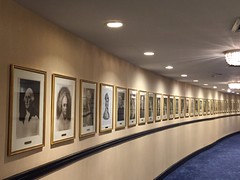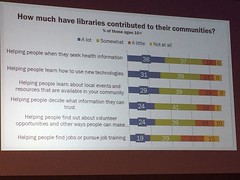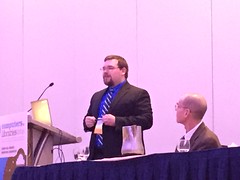 |
| A few SU iSchool MSLIS students and alumni |
Another
Computers in Libraries Conference has come and gone. It was full of new ideas, reminders of things already learned (but perhaps not yet done), good friends, and new members of my network (tribe).
This was the fourth year that I've been able to bring a group of MSLIS students to the conference. This year, seven students attended the conference, including one -
Kenneth Roman - who was also a
presenter. We crafted a three non-CIL events for them - a lunch with some alumni and two library tours - because D.C. provides that opportunity. Marrying a trip to D.C. with CIL for students creates a wonderful opportunity for them to hear from the profession, see the profession in action, and expand their networks. CIL is a diverse conference that engages them and gets them excited. For me, that is fun to watch.
 |
| David Mao and Sarah Weber |
Last year and this year, I've spent part of my time during CIL going to visit existing or prospective SU
iSchool employers. This year,
Sarah Weber, the SU iSchool Director of Employer Relations, and I visited people, including the Acting Librarian of Congress,
David Mao. Some of the employers we visit are unfamiliar with what iSchool students or MSLIS students are capable of. (For example, an IT company may need data analysts and not consider hiring an MSLIS for the position.) There are other employers that we just want to touch base with and provide an update. For me, this work adds an interesting and important dimension to the trip, and gives me information I can immediately pass along to students and recent alumni.
Thinking about the conference: This was my 11th consecutive CIL Conference. Yes, I've spoken at all eleven and moderated at a few of them. In 2007 (my first CIL), Tom Hogan announced the attendance as
being:
...more than 2,393 attendees at the conference, including those who are exhibiting. Attendees are here from 48 states (not North or South Dakota) and 12 countries (not counting the U.S.). There are 130 speakers and moderators. There are 66 companies exhibiting in the exhibit hall.
This year (2016) Hogan announced
that:
There are 1181 participants, 166 exhibits only participants, and 121
exhibitors (45 companies). There are participants from 45 states plus
DC and Puerto Rico, as well as 17 countries.
In a comment I made on Chris Zammerelli's
blog, I noted what I thought had changed to cause the lower attendance.
First, many conferences has seen a downturn due to organizational and personal finances, especially during the recession. This includes changes with the federal budget, which has (or had) limited the attendance of government librarians at CIL. Second, I think there are more professional development opportunities. I can do things online or locally that I once had to do at a conference. And I no longer need to go to a conference to see vendor products. Third, I think people go where their “tribe” is. Is there a tribe that attends CIL (or another conference) which is large enough to create that indefinable atmosphere that we might associate with a particular conference? Is the tribe influential enough to say to others “come with me” and have those people listen? My sense is that there is still a tribe at CIL, but that it has shifted and it not the lobbycon/tablecon/ya’ll come group that used to be there. (As a side note, the pre-CIL conversations that used to exist on social
media aren’t there anymore and fewer people are blogging. Are these
indications of a shift in the tribe?)
 |
| Topher Lawton, Jill H-W and Maurice Coleman |
Seth Godin wrote a book several years ago called
Tribes: We Need You to Lead Us
. The book sparked many discussions about how we connect with others, the power of connections, etc. Earlier this year, I heard
Caroline Haythornwaite talk about social networks in relation to learning. She has a a few interesting images of the connections between social networks. An event - any event - needs people who are strongly connected to each other and who will make new connections to others at the event. These new connections may be weak, but they provide an anchor for those who hadn't yet been connected and that anchor can help to bring them back. ("I'll see you next year, right?") Making these new connections requires work for everyone involved. In other words, just being in the same room does not mean you've built a new connection. You need to talk, share, and be active. And not only will this help to bring you back, it will provide a network to help you professionally in between conferences/events.
In 2007, I remember getting connected with others before even arriving at the conference. Those connections and the connections I made at the conference grew even stronger afterward through the sharing online of photos, blog posts, and other content. In other words, the event started before we met face-to-face and ended well afterward. In 2016, fewer people blogged, tweets, shared, or interacted before or after the conference. The interaction has changed. The tribe has changed. I think that has translated into part of the change in the numbers of participants.
To be clear,
this isn't just a CIL problem. Every conference has felt a change due at least to three things I've listed above. Every conference is thinking about the future - whether they say that publicly or not. As part of that thinking, I hope every conference will re-think its tribe.
And here is YOUR call to action! If you have attended CIL and found it helpful, tell someone else about the conference and encourage them to attend. If you have been to CIL in the past and it has dropped of your "must go" list, talk to your boss about whether it can go back on the "must go" list. If you met someone at CIL and haven't followed up, do it (and do it now). Make that connection stronger. If you heard a speaker and want to follow-up with that person, use the CIL web site to locate his/her contact information and make that connection.
 |
| Hallway outside of the ballrooms |
Food in DC: I have found over the years that it is helpful if I capture information on places I ate while at a conference. (I just recommended a restaurant in Philadelphia, whose name I had captured in a 2009 photo!) So where did I eat this year?
RFD (Chinatown),
Penn Commons (Chinatown),
Lauriol Plaza (Dupont Circle),
Afterwords Cafe (Dupont Circle),
DC Noodles (Adams Morgan), and
Bier Baron Tavern (Dupont Circle). And I had a drink at the
Gibson, which is a (legal) speakeasy in Adams Morgan.
Index of my 2016 CIL posts: I blogged every sessions that I attended and the two that I spoken in.
Finally, next year's conference will March 21-23, 2017 at the Washington Hilton. If you are interested in speaking at the conference, the call for speakers will be posted through social media, on the CIL web site, etc., during the summer.
Addendum (3:30 p.m.): During today's recording of T is for Training, I raised the idea of having a group a CIL whose job it is to help people find where things are and also help them make connection with others. ("Are you new to this conference? Let me introduce you to this person, whose been here before.") Those who are new to the conference might not consider the dine-arounds or meeting up with others (strangers) for lunch, but might be encouraged to do so if someone approached them with the idea. ("Where can I go for lunch and be able to talk to others from the conference?") The group - perhaps 15 people (five each day) - might be given a discounted registration in exchange for being connectors to people and information. I've seen this done at conference and other events, and it can be effective.
Addendum, 3/22/2016: This above actually is what a tribe does. When a tribe isn't doing it, then others must.











